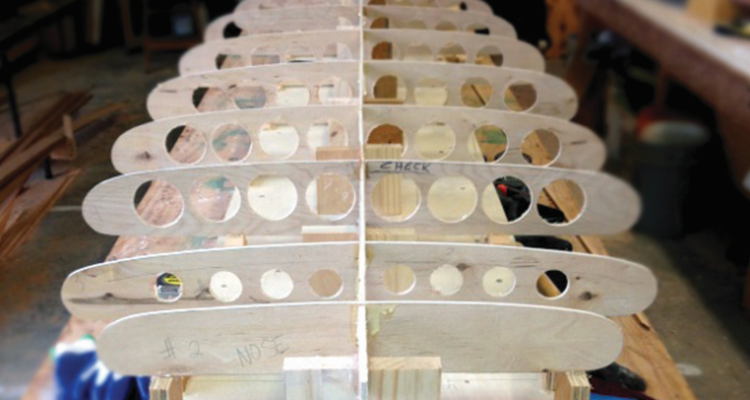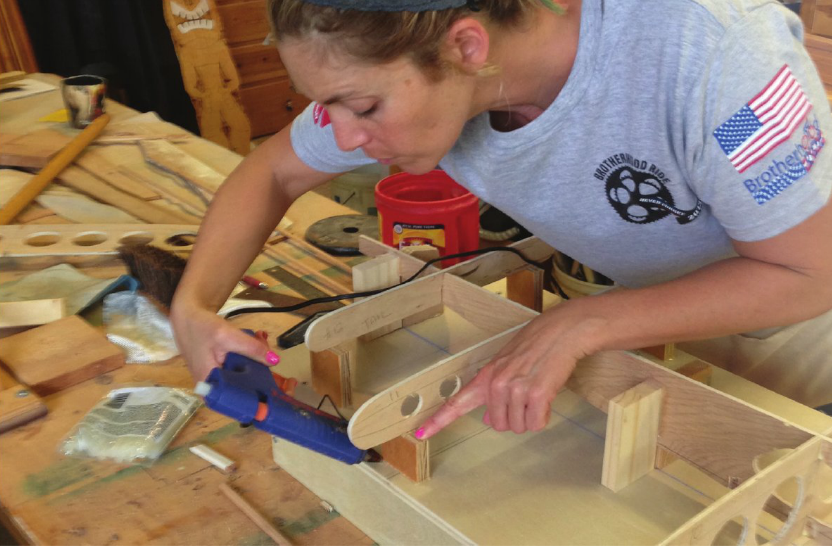A local entrepreneur shows our intrepid writer how to do it
On any given Saturday morning you can find the Gulf flecked with tanned and toned stand up paddleboarders plying the water. They glide along like proud, athletic swans, unhurried and graceful, just happy to be soaking up some sun.
Watch for long enough and you’ll want to join in; the allure of walking on water is seriously contagious. Unfortunately, in order to join in you need a board—something I was lacking. Until I met Neil Hamilton, owner of Pine Island-based Low Key Surfboards. Hamilton builds his own surfboards and standup paddleboards, but he also helps others do the same. He promised me that he could help me make my very own hollow cedar wood standup paddleboard. I thought about my high school shop days and wasn’t so sure. Here’s what happened.
From Home Building to Beaches and Boards
Like so many good ideas, Low key Surfboards—a Pine Island-based custom surf and standup paddleboard manufacturer—was born on the beach. Hamilton, who is 61—but says he feels 19, spent more than two decades as a general contractor first in New Jersey and then here locally.
Over the years, Hamilton built everything from custom homes to commercial buildings and all the little things in between. The process of taking a pile of raw materials and forming them into a home fascinated him. It’s the same process he revels in with his surfboards. The tough part was that it took all of his time. After working an eight-hour day Hamilton would go home to work on estimates, meet with customers, do billing and all the rest. Saturdays and Sundays were taken too. There was just wasn’t much free time to play.
Hamilton moved from the contracting business to the law enforcement business, joining the Lee County Sherriff’s office in 2001. The first seven years were primarily nights and the rest was in the zone of Fort Myers Beach. He was surrounded but sun, surf and sand daily, but never in a capacity in which he could interact with it.
While still working as a deputy, Hamilton bought plans online for building a wooden surfboard. The finished board was very basic, and while he wasn’t thrilled with it, the wheels had started to turn. Next he bought plans to build a wooden canoe. Those plans were slightly better, but Hamilton theorized that he could probably produce an even better set of DIYinstructions.
Looking out at the water from behind his Pine Island home, Low Key Surfbords was born.
Your Toolbox
“Woodworking is a dying art. You can’t Google everything,” says Hamilton. He adds that he finds it especially satisfying to watch teens and younger people take on projects. He loves seeing them working with their hands and creating something to use outdoors – away from television, the Internet and video games.
I ask, “Does one have to have special skills to build a board?”
He says that it’s definitely helpful to have some previous woodworking skills, but you don’t need to be the next Frank Lloyd Wright or Mike Holmes to be successful. At the very least, though, you do need to have some kind of zeal for working with your hands. Honestly, after spending a few weeks working on the board, I’d say that if you can put together a bookshelf from Walmart, you’re probably going to be okay.
You’ll also need at least a few power tools—or access to power tools—to finish the project. Be resourceful. You can get a table saw and other power tools at a box store for $100 each. You can also approach your local trade school, cabinet shop or contractor. We all know at least one guy in the neighborhood with a garage full of cool toys, right? Ask him (or her) and see if you can’t swap a few hours in their garage for a ride on the finished product.
Finally, you will need some space to lay out the board and a whole bunch of C-clamps. You’ll need some fiberglass—your local surf shop or boat builder may be able to supply that, and you’ll need a couple of large pieces of cedar. Definitely take the time to pick through and get the nice pieces when you’re at your local hardware store.
The Build Out
On the first day, we began by pulling out stacks of cedar about 10 feet long, six inches wide and one inch thick. They were huge. Then he showed me just how small the pieces were going to be cut; between an inch to a half inch. After a quick lesson with the table saw and lots of cutting, we began to route them to fit into one another.
I was so focused on my tasks that I actually forgot to eat. The rest of the day was spent measuring, cutting and sanding what would be the inside frame of the board.
Day two went much more slowly than day one. I spent about four hours with the drill press, drilling out “lightening holes”—which are drilled out of pieces of the internal frame to keep the board as light as possible. I quietly went about my task, drilling out about 100 holes.
The afternoon was spent taking the internal horizontal pieces of the board and fitting them into the vertical internal frame of the board. It was just like a puzzle, and an easy one at that.
I learned patience that day. Hamilton says it’s best not to have a specific timeline; sometimes what you think will be a 10-minute task turns into a couple hours. The blade on the jigsaw broke, the belt on the belt sander needed to be changed, and a few of the internal pieces were not measured correctly and had to be redone.
It took me a week to get back to the shop. I told Hamilton I wish I could take a month off of work and just live in the shop until it was completed. He laughed and said I was the most enthusiastic student he’s ever had.
Day three was more cutting, sanding, clamping and gluing. I think Hamilton owns stock in the c-clamp business; just one board uses at least 50 different clamps at any given time. However, by the end of the day my mess of wood parts was beginning to look like a board.
It’s addicting: The feel of the saw, the thrill of watching it come together, the reward of measuring twice and cutting right on the first try. A time or two Hamilton had to remind me that there’s no crying in woodworking, but really, I haven’t been this excited for a project in years. I can feel the water calling me every time I complete another step.
With Low Key Surfboards you can easily build your very own surfboard or standup paddleboard for between $300-$400. With Hamilton’s system you get a step-by-step DVD set, a complete shop manual and detailed blueprints. You also get the expertise of someone who has centered his life around building for a living and he’s only a phone call away. For the locals, there may even be an on-site build your own class in the future.
I’ve been spending every weekend at the shop and the progression is astounding. The first day I stood in a pile of pieces of cedar, and now I’m seeing a board come together. There’s nothing in the world like doing it yourself.


